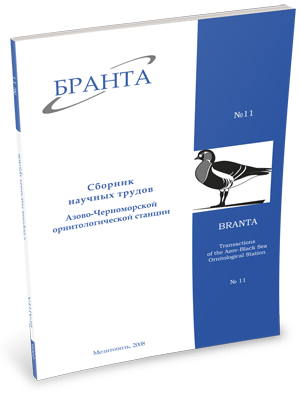
Transactions
of the Azov-Black Sea Ornithological Station



Cormorant at the southern coast and in the west of the Crimea
S.Yu. Kostin, N.A. Tarina, N.A. Bagrikova
Original and already published materials on the Cormorant (Phalacrocorax carbo) - a numerous and important for economy bird species of the Crimea are summarized in present paper. This publication is based on materials, collected by the authors in 1983-2008, archives and literary sources, and also data-base on ring recoveries from the birds, ringed in the Azov-Black Sea region was analyzed. The study area covers Kalamitskiy Bay and the Crimean coast of Karkinitskiy Bay, the western part of the mountain Crimea, including its southern coast from Sevastopol to village of Malorechenskoe.
Ànalysis of seasonal distribution and numbers of the Cormorant in the study region over the last 30 years did not show any changes in general characteristics of its phenological cycle. The species is rare and sporadic in May-June in the south of the peninsula and numerous within the breeding area on the Lebyazhy Islands. The general significant increase in numbers of the species all over the region and also a presence of non-breeding birds in structure of the population resulted in more frequent observations of the Cormorants during the breeding period (May-June) at the southern coast of the Crimea and in Kalamitskiy Bay.
Distribution of the Cormorant colonies in the region is determined by presence of fish-farms near the North-Crimean canal. Proceeding from the ringing data, the birds of all age groups migrate in vicinity of colonies as well as far away, since the juveniles left their nests. Perhaps, intensification of fish-farming caused postbreeding concentration of the Cormorants in the mouth of Kacha River in July-September and more frequent observations of the species at the water bodies within Crimean foothills (Simferopolskoe, Partizanskoe reservoirs) during this period.
Increase in reserves of the main prey species of the Cormorants (mackerels, mullets) near the southern coasts over the last decade resulted in growth of the Cormorant numbers during the winter period and earlier appearance of autumn migrants in this region. Proceeding from the ringing data, the Cormorants wintering near the southern coasts of the Crimea belong to breeding groupings from the North Crimea, Kuban and the Sea of Azov region. Forming of the Cormorant colonies in the northern and north-eastern Crimea over the second half of 1970s led to appearance of the new migratory flows that may be observed during spring migration. Before 1970s, at the southern coast of the Crimea intensive passage of the Cormorants in February-March in western direction was known. Later a spring migratory flow in eastern direction was observed to the east from Alushta. During the last ten years pronounced migration is observed near the south-eastern coast (in north-eastern direction) and western coast (in north direction) of the mountain Crimea. Migrants occurring in mountains and foothills pass in the eastern and north-eastern directions.
At the breeding area on Lebyazhy Islands the Cormorants appear in February, egg laying begins within 30-40 days after arrival, depending from spring course. Maximum in the breeding numbers is observed in middle-late May, mass appearance of fledglings - in June-July, disintegration of the colony - in August, but gatherings in roosting places in August-September number up to 1500 birds. In October number of the species near the colony declines nearly in half, in November most Cormorants depart and in winter about a score of birds stay here. The dynamics of the Cormorant numbers on Lebyazhy Islands show continuous increase in 1980s, decline in numbers after the winter of 1984/1985, its growth in 1990s and future increase over the last decade. The Cormorant through its vital functions exerts influence on a vegetation and ornithocomplexes of the islands, especially during the nest building. Fledglings also trample vegetation and negative effects of a soil compression and inhibition of plants by excrements are noted. As a result, the impoverishment of cenosis structure of the island complexes (replacement of perennials by annuals), degradation of grassy turf due to direct extermination of plants and finally - the intensification of soil erosion by wind, reduction of steadiness of accumulative shoes against waves may be observed. Direct influence on ornithocomplexes of the islands also is negative. The Cormorants trample nests of terns and displace the other species (such as Caspian Tern and Great Black-headed Gull) that use similar nesting sites (safe in a case of storm) from their traditional breeding places.
Breeding density of the Yellow-legged Gull and ducks also decrease because they need for nesting thin or close communities of perennials that provide protective functions, but undersized communities of annuals are useless for them.
Taking into account a reserve status of the Lebyazhy Islands, where waterbird complexes including a lot of rare and threatened species are protected and proceeding from peculiarities of the Cormorant biology within this area, the most effective measure for significant decrease in Cormorant numbers that provides safety for the other bird species is a method of the repeated (till end June) removal of clutches from nests during the shot-term visitations of the nesting places.
Read the paper in a PDF file